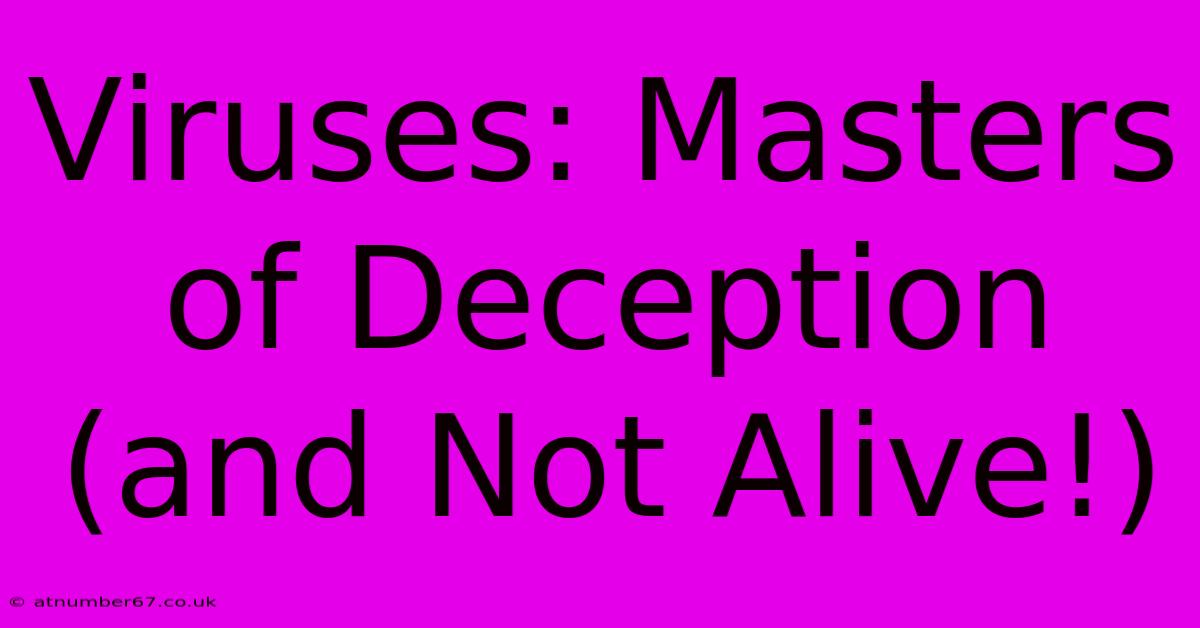Viruses: Masters Of Deception (and Not Alive!)

Table of Contents
Viruses: Masters of Deception (and Not Alive!)
Viruses. The word conjures images of sickness, fear, and microscopic mayhem. But what exactly are these tiny entities that wreak such havoc on our bodies and even our technology? The short answer is surprisingly simple: they're masters of deception, incredibly efficient at hijacking cellular machinery, but surprisingly, they're not technically alive.
The Not-So-Simple Definition of Life
Before diving into the deceptive nature of viruses, let's address the elephant in the room: their non-living status. While they exhibit some characteristics of living organisms, like replication and evolution, they lack others that are crucial for defining life. Specifically, viruses:
- Lack cellular structure: Unlike bacteria, which are single-celled organisms, viruses are essentially genetic material (DNA or RNA) encased in a protein coat. They don't have the cellular machinery needed for independent metabolism or reproduction.
- Require a host: Viruses are obligate intracellular parasites. This means they must invade a host cell to replicate. They hijack the host's cellular machinery to create more virus particles, effectively turning the cell into a virus factory.
- Don't independently metabolize: Viruses lack the necessary enzymes and organelles to carry out metabolic processes like energy production. They rely entirely on their host cell for energy and resources.
This dependence on a host cell is a key reason why many scientists don't consider viruses to be truly alive. They are more accurately described as complex molecular machines capable of self-assembly and replication, but lacking the fundamental characteristics of independent living entities.
Masters of Deception: Viral Strategies
Despite their non-living nature, viruses are incredibly successful parasites. Their success stems from their sophisticated strategies for infecting and manipulating host cells. These strategies often involve:
Attachment and Entry:
Viruses employ highly specific mechanisms to attach to and enter host cells. Their protein coats contain receptors that precisely bind to complementary receptors on the surface of the target cell. This ensures that the virus infects the correct cell type. This precise targeting is a key aspect of their deceptive nature.
Hijacking Cellular Machinery:
Once inside the cell, viruses unleash their genetic material. This genetic material instructs the host cell's ribosomes to produce viral proteins. The virus essentially takes over the cell's protein synthesis machinery, diverting resources away from the cell's normal functions.
Replication and Assembly:
New viral particles are then assembled from the newly synthesized viral proteins and genetic material. This process often results in the destruction of the host cell, releasing thousands of new viruses to infect more cells. This efficient replication is a hallmark of viral success.
Evasion of the Immune System:
Viruses have also evolved clever strategies to evade the host's immune system. Some viruses mutate rapidly, making it difficult for the immune system to recognize and eliminate them. Others cloak themselves in host proteins, effectively disguising themselves from immune cells. This constant arms race between viruses and the immune system is a driving force behind viral evolution.
The Impact of Viruses: Beyond Disease
While viruses are infamous for causing diseases, their impact extends far beyond human health. Viruses play a significant role in:
- Evolution: Viruses have shaped the evolution of many organisms, including humans, through horizontal gene transfer. This process involves the transfer of genetic material between unrelated organisms, often mediated by viruses.
- Ecology: Viruses are involved in regulating populations of bacteria, archaea, and other organisms in diverse ecosystems. They are a major driving force of microbial diversity.
- Biotechnology: Viruses are used in various biotechnological applications, including gene therapy and vaccine development. Their ability to deliver genetic material into cells is being harnessed for therapeutic purposes.
Conclusion: Understanding the Enemy
Viruses, although not technically alive, are undeniably powerful biological entities. Understanding their deceptive strategies, their complex interactions with host cells, and their broader impact on the environment is crucial for developing effective strategies to combat viral diseases and harness their potential for beneficial applications. Their existence challenges our very definition of life and highlights the remarkable diversity and adaptability of the biological world.

Thank you for visiting our website wich cover about Viruses: Masters Of Deception (and Not Alive!). We hope the information provided has been useful to you. Feel free to contact us if you have any questions or need further assistance. See you next time and dont miss to bookmark.
Featured Posts
-
Russell Henley Net Worth Endorsements And Sponsorships
Apr 01, 2025
-
Mbappes Net Worth Inspired By Success
Apr 01, 2025
-
What You Didnt Know About Michael Polanskys Age
Apr 01, 2025
-
Frida Mom Underwear Designed For You
Apr 01, 2025
-
Age Of Consent A Critical Examination Of Trinidads Laws
Apr 01, 2025
